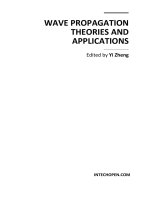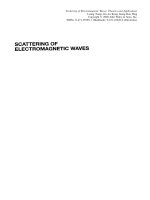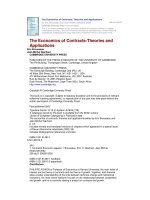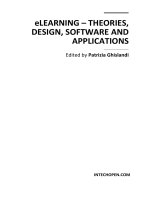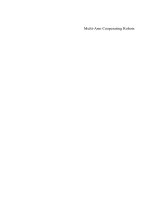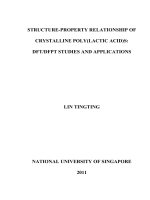Introducing translation studies theories and applications
Bạn đang xem bản rút gọn của tài liệu. Xem và tải ngay bản đầy đủ của tài liệu tại đây (2.43 MB, 395 trang )
Introducing Translation Studies
Introducing Translation Studies remains the definitive guide to the theories and concepts that
make up the field of translation studies. Providing an accessible and up-to-date overview, it has
long been the essential textbook on courses worldwide.
This fourth edition has been fully revised and continues to provide a balanced and detailed
guide to the theoretical landscape. Each theory is applied to a wide range of languages, including
Bengali, Chinese, English, French, German, Italian, Punjabi, Portuguese and Spanish. A broad
spectrum of texts is analysed, including the Bible, Buddhist sutras, Beowulf, the fiction of García
Márquez and Proust, European Union and UNESCO documents, a range of contemporary films, a
travel brochure, a children’s cookery book and the translations of Harry Potter.
Each chapter comprises an introduction outlining the translation theory or theories, illustrative
texts with translations, case studies, a chapter summary and discussion points and exercises.
New features in this fourth edition include:
Q new material to keep up with developments in research and practice, including the sociology
of translation, multilingual cities, translation in the digital age and specialized, audiovisual and
machine translation
Q revised discussion points and updated figures and tables
Q new, in-chapter activities with links to online materials and articles to encourage independent
research
Q an extensive updated companion website with video introductions and journal articles to
accompany each chapter, online exercises, an interactive timeline, weblinks, and PowerPoint
slides for teacher support
This is a practical, user-friendly textbook ideal for students and researchers on courses in Translation
and Translation Studies.
Jeremy Munday is Professor of Translation Studies at the University of Leeds, UK, and is a quali-
fied and experienced translator. He is author of Style and Ideology in Translation (Routledge 2008)
and Evaluation in Translation (Routledge 2012), editor of The Routledge Companion to Translation
Studies (2009) and co-author, with Basil Hatim, of Translation: An Advanced Resource Book
(Routledge 2004).
Praise for this edition
‘Jeremy Munday’s Introducing Translation Studies has long been admired for its combination of
theoretical rigour and down-to-earth explanation, and this new edition will further confirm its place
as the go-to introduction for students and teachers alike. Its further incorporation of ideas from the
Chinese context is particularly welcome.’
Robert Neather, Hong Kong Baptist University, China
‘An even better fourth edition of a widely popular and commonly used book in Translation Studies
(TS). Munday’s volume is a sound and accessible introduction to TS, combining scholarly rigor with
reader-friendly style and an excellent didactic orientation, which will continue to make this book
highly attractive to students, teachers and newcomers.’
Sonia Colina, University of Arizona, USA
Praise for the third edition
‘This book provides a comprehensive and precise coverage of the major theories of translation …
The discussion and research points at the end of each topic will be welcomed by students, teachers
and researchers alike … written in exceptionally clear and user-friendly style … Readers who may
have no previous knowledge of translation studies will also find the book interesting and
illuminating.’
Susan Xu Yun, SIM University, Singapore
‘Whether you are a researcher, teacher, practitioner or learner of translation, you should read this
book to get a comprehensive view of translation theories of the world, at present and in the past.
This book is extremely useful as the starting point for understanding translation theories. It is deep
enough for you to get adequate details and broad enough to let you know which directions to follow
in your further research.’
Chris Shei, Swansea University, UK
‘Jeremy Munday covers it all in this up-to-date book. It covers most, if not all, aspects of translation,
whether they are theoretical or practical. This book is also an essential resource of knowledge for
professional, academic, and practicing translators. Many approaches to translation are clearly and
thoroughly explained.’
Said M. Shiyab, UAE University, UAE
‘It would be difficult to find a better introduction to the complex field of translation studies … A real
must for everybody interested in this discipline.’
María Sánchez, University of Salford, UK
‘This updated edition of Introducing Translation Studies provides a clear, thorough, and balanced
introduction to major past and current trends in translation studies. It will be of great assistance to
translation instructors and students seeking an updated overview of the field.
Franỗoise Massardier-Kenney, Kent State University, USA
Introducing Translation
Studies
Theories and applications
Fourth Edition
JEREMY MUNDAY
Fourth edition published 2016
by Routledge
2 Park Square, Milton Park, Abingdon, Oxon OX14 4RN
and by Routledge
711 Third Avenue, New York, NY 10017
Routledge is an imprint of the Taylor & Francis Group, an informa business
© 2016 Jeremy Munday
The right of Jeremy Munday to be identified as author
of this work has been asserted by him in accordance
with sections 77 and 78 of the Copyright, Designs and
Patents Act 1988.
All rights reserved. No part of this book may be reprinted or
reproduced or utilized in any form or by any electronic,
mechanical, or other means, now known or hereafter
invented, including photocopying and recording, or in any
information storage or retrieval system, without permission in
writing from the publishers.
Trademark notice: Product or corporate names may be trademarks
or registered trademarks, and are used only for identification and
explanation without intent to infringe.
First edition published by Routledge 2001
Second edition published by Routledge 2008
Third edition published by Routledge 2012
British Library Cataloguing in Publication Data
A catalogue record for this book is available from the British Library
Library of Congress Cataloging in Publication Data
Names: Munday, Jeremy, author.
Title: Introducing translation studies : theories and applications / by
Jeremy Munday.
Description: Fifth Edition. | Milton Park ; New York : Routledge, 2016. |
Includes bibliographical references and index.
Identifiers: LCCN 2015039263 | ISBN 9781138912540 (pbk.) | ISBN 9781138912557
(pbk.) | ISBN 9781315691862 (ebk.)
Subjects: LCSH: Translating and interpreting.
Classification: LCC P306 .M865 2016 | DDC 418/.02—dc23
LC record available at />
ISBN: 978-1-138-91254-0 (hbk)
ISBN: 978-1-138-91255-7 (pbk)
ISBN: 978-1-315-69186-2 (ebk)
Typeset in Berthold Akzidenz Grotesk
by RefineCatch Limited, Bungay, Suffolk
Additional materials are available on the companion website at www.routledge.com/cw/munday
Para Cristina,
que me ha hecho feliz
This page intentionally left blank
Contents
A visual tour of Introducing Translation Studies x
List of figures and tables xiii
Acknowledgements xv
List of abbreviations xvii
Introduction 1
Chapter 1 Main issues of translation studies 7
1.1 The concept of translation 8
1.2 What is translation studies? 10
1.3 An early history of the discipline 13
1.4 The Holmes/Toury ‘map’ 16
1.5 Developments since Holmes 21
1.6 The van Doorslaer ‘map’ 22
1.7 Discipline, interdiscipline or multidiscipline? 24
Chapter 2 Translation theory before the twentieth century 29
2.0 Introduction 30
2.1 ‘Word-for-word’ or ‘sense-for-sense’? 30
2.2 Early Chinese and Arabic discourse on translation 33
2.3 Humanism and the Protestant Reformation 38
2.4 Fidelity, spirit and truth 40
2.5 Early attempts at systematic translation theory:
Dryden, Dolet, Tytler and Yán Fù 42
2.6 Schleiermacher and the valorization of the foreign 47
2.7 Towards contemporary translation theory 49
Chapter 3 Equivalence and equivalent effect 58
3.0 Introduction 59
3.1 Roman Jakobson: the nature of linguistic meaning and equivalence 59
3.2 Nida and ‘the science of translating’ 62
3.3 Newmark: semantic and communicative translation 71
3.4 Koller: equivalence relations 74
3.5 Later developments in equivalence 77
viii CONTENTS
Chapter 4 Studying translation product and process 86
4.0 Introduction 87
4.1 Vinay and Darbelnet’s model 88
4.2 Catford and translation ‘shifts’ 95
4.3 Option, markedness and stylistic shifts in translation 98
4.4 The cognitive process of translation 100
4.5 Ways of investigating cognitive processing 103
Chapter 5 Functional theories of translation 113
5.0 Introduction 114
5.1 Text type 114
5.2 Translatorial action 124
5.3 Skopos theory 126
5.4 Translation-oriented text analysis 131
Chapter 6 Discourse and Register analysis approaches 141
6.0 Introduction 142
6.1 The Hallidayan model of language and discourse 142
6.2 House’s model of translation quality assessment 145
6.3 Baker’s text and pragmatic level analysis: a coursebook
for translators 149
6.4 Hatim and Mason: the levels of context and discourse 156
6.5 Criticisms of discourse and Register analysis approaches
to translation 159
Chapter 7 Systems theories 169
7.0 Introduction 170
7.1 Polysystem theory 170
7.2 Toury and descriptive translation studies 174
7.3 Chesterman’s translation norms 186
7.4 Other models of descriptive translation studies: Lambert and van
Gorp and the Manipulation School 189
Chapter 8 Cultural and ideological turns 197
8.0 Introduction 198
8.1 Translation as rewriting 199
8.2 Translation and gender 205
8.3 Postcolonial translation theory 208
8.4 The ideologies of the theorists 213
8.5 Translation, ideology and power in other contexts 214
Chapter 9 The role of the translator: visibility, ethics and sociology 222
9.0 Introduction 223
9.1 The cultural and political agenda of translation 223
9.2 The position and positionality of the translator 233
9.3 The sociology and historiography of translation CONTENTS ix
9.4 The power network of the translation industry
9.5 The reception and reviewing of translations 236
239
Chapter 10 Philosophical approaches to translation 241
10.0 Introduction
10.1 Steiner’s hermeneutic motion 249
10.2 Ezra Pound and the energy of language 250
10.3 The task of the translator: Walter Benjamin 250
10.4 Deconstruction 258
260
Chapter 11 New directions from the new media 262
11.0 Introduction
11.1 Audiovisual translation 274
11.2 Localization, globalization and collaborative translation 275
11.3 Corpus-based translation studies 275
287
Chapter 12 Research and commentary projects 291
12.0 Introduction
12.1 Consilience in translation studies 302
12.2 Translation commentaries 303
12.3 Research projects in translation studies 303
306
Notes 314
Bibliography
Index 319
328
361
A visual tour of Introducing
Translation Studies
Pedagogical features
Introducing Translation Studies offers a variety of ways to help lecturers introduce this vibrant
discipline, and to help students understand the key concepts and issues.
KKeey ycocncoenptcse KEY CONCEPTS Each chapter opens with a
series of straightforward definitions of the key
Q Definitions of translating and interpreting. concepts that the chapter will cover.
Q Definitio
Q The practice of translating is long established, b
Q oTf thraensplartiaocn studies is new.
KKeyetyexttes xts KEY TEXTS Essential articles and books in the
topic area.
Baker, Mona and Gabriela Saldanha (eds) (2009) The R
Boaf Tkraenrs,laMtionoSntudies, Part II: History and Traditions, 2n
New York: Routledge.
of Transla
CCaasseestsudtyudy CASE STUDIES Case studies in each chapter to
give focus and insight into the theories discussed.
The following case study considers two series of transla
TviehweoffoNlildoaw’s ifnorgmal and dynamic equivalence. The three
from English translations from the Hebrew of the openi
biook tfheNOidld ’
of of the Christian Bible. 10
Testament
1E.x1pEloxprloartaitoionn: The term ‘translation’ EXPLORATION Within each chapter there are
links to extra journal material on the ITS companion
Which word(s) are used for ‘translation’ in the languag website to encourage further exploration of ideas.
cEhxpwloorerdth(esir)oraigrins. What do these terms suggest abou
lozraetiotnhoefirtraonrsilgatiinon?
Discussion and research points DISCUSSION AND RESEARCH POINTS At the
end of each chapter are a number of questions
Discussion that can be set as assignments, or discussed in
class. They can also serve as a platform for
1 Look again at the analysis in the case study. Are the related research project ideas.
1 Ldiosaogkreeagwaith the analysis? What does this tell us a
kind of model? The analysis focuses on the seven pr
FFuurrthtehrerreardeing FURTHER READING Additional sources for
students to explore particular issues raised in the
See Hatim (2009) for a useful overview of discourse an chapter.
SitsereelaHtioantitmo fu(2nctional theories, and also Baker et al.
recent studies. See Halliday and Hasan (1976) for
it l ti t
Companion website
www.routledge.com/cw/munday
Introducing Translation Studies also
includes a comprehensive companion
website of online resources for both
students and lecturers. These include:
Student resources
Q Video presentation by the author on
each chapter, discussing the key
issues for students to consider
Q Interactive timeline to explain how
translation theories have evolved since
the first theorists
Q Multiple-choice questions to test
understanding of definitions and
concepts
Q Additional discussion questions and
further reading
Lecturer resources
Q PowerPoint presentations for each chapter, which can be downloaded and annotated,
providing lecturers with a ready-made foundation for lecture preparation
Q Free access to journal articles with accompanying teaching notes
This page intentionally left blank
Figures and tables
Figures
1.1 Holmes’s ‘map’ of translation studies 17
1.2 The applied branch of translation studies 20
1.3 Translation strategies 23
1.4 Translation procedures 24
3.1 Nida’s three-stage system of translation 63
5.1 Reiss’s text types and text varieties 116
5.2 Text type and relevant criteria for translation 122
6.1 The Hallidayan model of language 143
6.2 Revised scheme for analysing and comparing original and translated texts 146
7.1 Conditions when translation is in primary position in polysystem 173
7.2 Toury’s initial norm and the continuum of adequate and acceptable translation 178
7.3 Initial, preliminary and operational norms 179
8.1 Control factors inside and outside the literary system 201
9.1 Domestication and foreignization: ethical and discursive levels 228
10.1 Steiner’s hermeneutic motion 252
11.1 Concordance sample of loom large 297
11.2 Concordance sample of se cierne(n) 298
Tables
3.1 Example of componential analysis 66
3.2 Comparison of Newmark’s semantic and communicative translation 72
3.3 Characteristics of research foci for different equivalence types 76
4.1 Segmentation of text into units of translation 106
5.1 Functional characteristics of text types and links to translation methods 115
6.1 Register variables and their typical realizations 145
6.2 Forms of cohesion 152
7.1 Comparison of Toury’s and Chesterman’s norms 188
11.1 Multimodal transcription model 282
12.1 Example translation specification sheet 307
12.2 Comparison of terminology for orientation of strategies 311
12.3 Types of research questions 315
12.4 Types of hypotheses 315
This page intentionally left blank
Acknowledgements
I would like to thank the following copyright holders for giving permission to
reproduce the following: Figure 1.1, reproduced from G. Toury, Descriptive
Translation Studies – And Beyond, revised edition copyright 2012, Amsterdam
and Philadelphia, PA: John Benjamins. Figures 1.3 and 1.4 reproduced from L. van
Doorslaer ‘Risking conceptual maps’, in Yves Gambier and Luc van Doorslaer
(eds) The Metalanguage of Translation, special issue of Target 19.2: 217–33, reis-
sued in Benjamins Current Topics 20 in 2009. Figure 5.2, reproduced from
M. Snell-Hornby, Translation Studies: An Integrated Approach, copyright 1998,
Amsterdam and Philadelphia, PA: John Benjamins. All the above reproduced with
kind permission by John Benjamins Publishing Company, www.benjamins.com.
Figure 3.1, reproduced from E. Nida and C. R. Taber, The Theory and Practice
of Translation, copyright 1969, Leiden: E. J. Brill. Figure 6.2, reproduced from
J. House, Translation Quality Assessment: Past and Present, copyright 2015,
Routledge. Table 5.1, translated and adapted from K. Reiss, Möglichkeiten und
Grenzen der Übersetzungskritik; the original is copyright of K. Reiss. While every
effort has been made to trace copyright holders and obtain permission, this may
not have been possible in all cases. Any omissions brought to the publisher’s atten-
tion will be remedied at the earliest opportunity.
The case study in Chapter 8 is a revised and abridged version of an article of
mine: ‘The Caribbean conquers the world? An analysis of the reception of García
Márquez in translation’, published in Bulletin of Hispanic Studies, 75.1(1998):
137–44.
Introducing Translation Studies has evolved over time, but I acknowledge my
sincere debt to Lawrence Venuti (Temple University, USA) for his encourage-
ment with the initial project and for his detailed comments and suggestions on
drafts of the first edition.
My thanks also go to Rana Nayar (Reader, Department of English at Panjab
University, Chandigarh, India) for his assistance with the case study in Chapter 9.
I also thank colleagues at the Universities of Leeds, Surrey and Bradford for their
support during the writing of the various editions of this book, and to my students
xvi ACKNOWLEDGEMENTS
at all those institutions and universities where I have been lucky enough to be
invited to speak, who have responded to versions of this material. My thanks also
to all who have contacted me with comments on the earlier editions with sugges-
tions for revision, to those journal reviewers who have made constructive sugges-
tions and most particularly to the reviewers of the proposal and drafts for this
fourth edition.
There are many other translation studies colleagues who have offered
suggestions and help in many ways. I thank them all.
I would also like to express my extreme gratitude to Louisa Semlyen, Laura
Sandford and everyone at Routledge, who have been so very supportive and
patient throughout the writing and editing process. Also to Anna Callander for
her careful attention to detail. And thanks to Jacob Blakesley and Falih Al-Emara
for help with the index. Any remaining errors or deficiencies are of course mine
alone.
Finally, but most of all, my thanks to Cristina, whose love and help mean so
much to me, and to Nuria and Marina, who continue to add so much more to my
life.
Jeremy Munday
London, August 2015
Abbreviations
#$& Before Common Era
$& Common Era
DTS descriptive translation studies
SL source language
ST source text
TL target language
TT target text
This page intentionally left blank
Introduction
Translation studies is the now established academic discipline related to the
study of the theory, practice and phenomena of translation. This book brings
together and clearly summarizes the major strands of translation studies, in order
to help readers acquire an understanding of the discipline and the necessary
background and tools to begin to carry out their own research. It also presents
and discusses theoretical frameworks into which professional translators and
trainee translators can place their own practical experience.
The first three editions of Introducing Translation Studies (2001, 2008 and
2012) presented a practical introduction to an already diverse field. This fourth
edition, while maintaining the structure and much of the material, is fully revised
and updated. New content has been included throughout, ‘exploration boxes’
have been inserted within the text to link to full-text articles available on the
Introducing Translation Studies companion website ( />cw/munday) and other material has been located online. The website also contains
new video summaries of each chapter and revised PowerPoint presentations that
may be customized by the tutor.
However, the general structure of the book remains the same. It sets out to
give a critical but balanced survey of many of the most important trends and
contributions to translation studies in a single volume, written in an accessible
style. The different contemporary models are applied to illustrative texts in brief
case studies so that the reader can see them in operation. The new research
contained in these case studies, together with the ‘discussion and research
points’ sections, is designed to encourage further exploration and understanding
of translation issues.
The book is designed to serve as a coursebook for undergraduates
and postgraduates in translation, translation studies and translation theory, and
as a solid theoretical introduction for students, researchers, instructors and
professional translators. The aim is to enable the readers to develop their under-
standing of the issues and associated technical language (metalanguage), and
